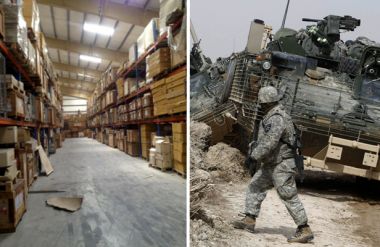Introduction

SIGAR.mil, Pier Paolo Cito/AP
The purchase of spare parts by the U.S. military is a big business, with more than $25 billion worth of screws and widgets kept in storerooms. It is also a notoriously sloppy one. Pentagon auditors have found that, due to poor bookkeeping, the military services regularly buy parts that they already have plenty of. Due to poor oversight, moreover, they frequently pay too much for them.
A partly-plastic roller wheel for an aircraft ramp worth a bit more than $7 is billed to the Pentagon at $1,678. “Commander” seats for Stryker armored vehicles are purchased long after they became obsolete. A 38-year supply of parts is stocked for an aircraft with a much shorter lifespan. “Do we have enormous warehouses sitting around with stuff that no one is going to use?” asked a senior defense official who briefed reporters over breakfast on these and other episodes earlier this year. “Yes.”
Now, in an act of generosity, the Pentagon has successfully exported its spare parts mismanagement to Afghanistan. It seems that a multinational, U.S.-led military office called the Combined Security Transition Command-Afghanistan spent $370 million from 2004 through the middle of this year on spare parts for vehicles operated by the Afghan National Army. But last year, it confirmed that it could not account for $230 million worth of the spare parts, according to an Oct. 16 report by the Special Inspector for Afghanistan Reconstruction.
Not only that, the multinational office ordered another $138 million worth of spare parts to cover purported shortages, but without determining first whether the needed screws and widgets were already in stock. Why? Well, the military relied on the Afghans to keep records of its inventory. And the Afghans, according to the audit, did not keep those records up to date. When auditors asked, the office couldn’t find any written justification for the new parts orders.
“CSTC-A officials … had no historical demand and usage data from the [Afghan Army] or contractors to support their $130 million in parts orders,” said the report, which was signed by special inspector general John F. Sopko. Nor could the office provide any documentation confirming that the Afghan Army actually received all the parts that were ordered.
Some of the purchases are continuing, apparently on autopilot, with a stream of revenues going to the companies that make the vehicles and their components. And it may get worse, since the multilateral office intends to turn over the authority to make spare parts purchases — funded by U.S. and allied grants — to the Afghan Army itself.
“Guessing is not appropriate when spending tax dollars,” Sopko said in a statement to the Center for Public Integrity. “The United States has spent hundreds of millions on spare parts that are unaccounted for.”
His report is decorated with photos of “non-inventoried” spare parts in boxes piled high outdoors and in a warehouse, located in different regions of the country. The Army, the report says, “lacks the staff to conduct inventories.” After visiting Kabul and the provinces of Mazar-e-Sharif, Helmand, and Kandahar, his auditors were told, they said, that some containers are not inventoried for a year, “leaving contents susceptible to theft.”
The entire process leaves “U.S.-purchased equipment and funds vulnerable to waste, fraud and abuse,” the report said.
Sopko’s report had a bright spot: He said the multinational office had taken the auditors’ warnings to heart, and promised to create a “transfer point” where incoming parts would be inventoried and their handover to Afghan officials officially recorded. The office also promised to try to pull uninventoried parts back into its custody, in preparation for a formal transfer and signing-off.
In a written reply to the report, the multinational office attributed the pileup of uninventoried equipment partly to a consolidation in Kabul of material formerly held at other depots, and also to a sudden opening of some supply lines. But the office agreed to defer purchases of non-critical parts until the inventories are completed.
“I’m pleased,” Sopko said, that the multinational force “is taking our recommendations seriously. The test will be in whether they implement procedures that are effective. We’re hopeful, but the proof is in the pudding.”
Read more in National Security
National Security
The mess gets worse at Hanford’s nuclear site
A scientific dispute over the cleanup of one of the most polluted sites in the country threatens to ensnare the Energy Department’s new leadership
Up in Arms
Arms export rules relaxed
A stream of military equipment exports will soon bypass State Department scrutiny

Join the conversation
Show Comments